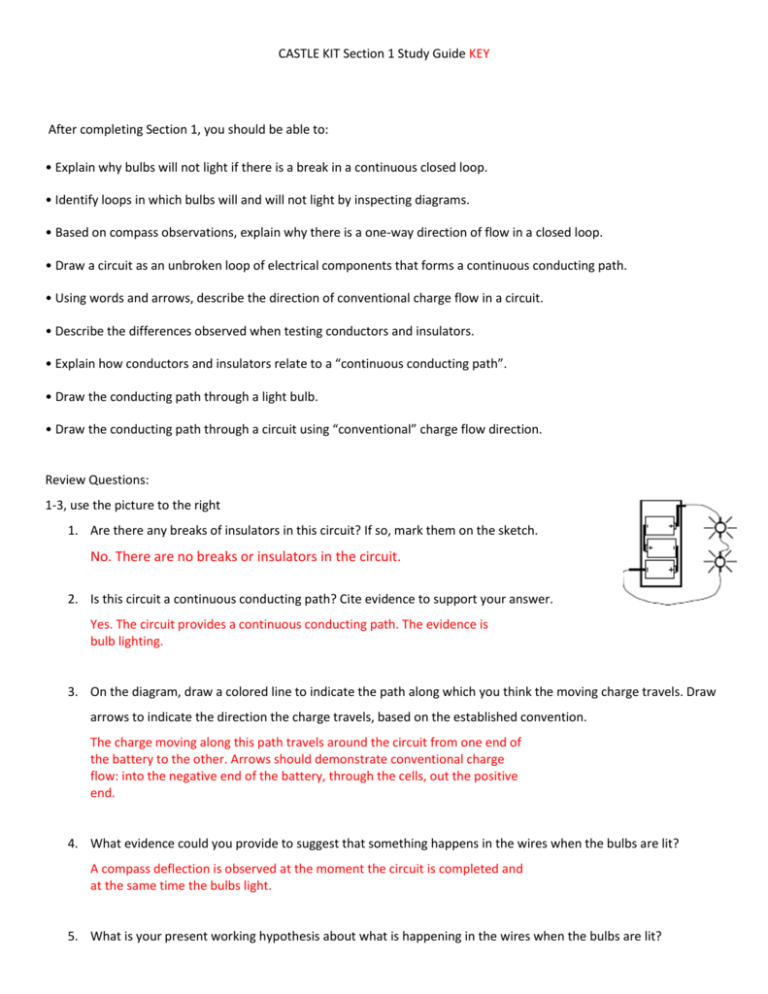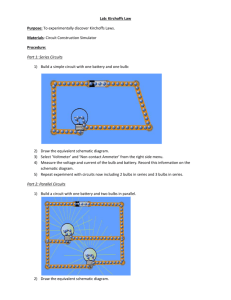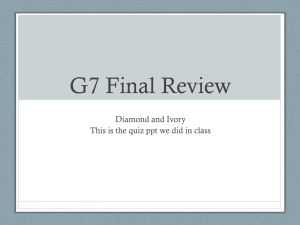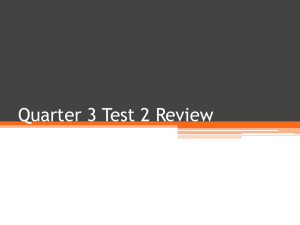CASTLE KIT Section 1 Study Guide KEY After completing Section 1
advertisement

CASTLE KIT Section 1 Study Guide KEY After completing Section 1, you should be able to: • Explain why bulbs will not light if there is a break in a continuous closed loop. • Identify loops in which bulbs will and will not light by inspecting diagrams. • Based on compass observations, explain why there is a one-way direction of flow in a closed loop. • Draw a circuit as an unbroken loop of electrical components that forms a continuous conducting path. • Using words and arrows, describe the direction of conventional charge flow in a circuit. • Describe the differences observed when testing conductors and insulators. • Explain how conductors and insulators relate to a “continuous conducting path”. • Draw the conducting path through a light bulb. • Draw the conducting path through a circuit using “conventional” charge flow direction. Review Questions: 1-3, use the picture to the right 1. Are there any breaks of insulators in this circuit? If so, mark them on the sketch. No. There are no breaks or insulators in the circuit. 2. Is this circuit a continuous conducting path? Cite evidence to support your answer. Yes. The circuit provides a continuous conducting path. The evidence is bulb lighting. 3. On the diagram, draw a colored line to indicate the path along which you think the moving charge travels. Draw arrows to indicate the direction the charge travels, based on the established convention. The charge moving along this path travels around the circuit from one end of the battery to the other. Arrows should demonstrate conventional charge flow: into the negative end of the battery, through the cells, out the positive end. 4. What evidence could you provide to suggest that something happens in the wires when the bulbs are lit? A compass deflection is observed at the moment the circuit is completed and at the same time the bulbs light. 5. What is your present working hypothesis about what is happening in the wires when the bulbs are lit? There is something moving in the wires and it moves in the same direction around the circuit. 6. What happens in the wires when the battery connections are reversed? What is your evidence? Something in the wires moves in the opposite direction – because the compass deflection reverses direction. 7. What is the battery doing when the bulbs are lit? The battery is acting like a pump, which causes charge to circulate around the loop. 8. Based on the assumption that something flows through wires when bulbs are lit in a circuit, is the direction of the flow the same in all the wires, or does it vary in different parts of the circuit? What is the evidence for your answer? The direction of flow is the same in all wires in a simple circuit, as indicated by the direction of the compass deflection, which is the same for all wires. 9. What materials and conditions must be present for a bulb to light? Explain carefully. Battery, wires, and an unbroken loop. The complete loop must contain the wire and both ends of the battery as well as both the tip and threaded section of the bulb. 10. On this cross-section diagram of a bulb in its socket, draw a heavy line to show a continuous conducting path that starts at a wire attached to one clip, goes through the bulb and exits through a wire at the other clip. 11. Based on your observations and ideas up to this point, how would you define the term ‘electricity’. ‘Electricity’ is the flow of charge in a continuous conducting path or circuit. 12. In the following circuit, which bulb lights first? _______ (A) Bulb A (B) Bulb B (C) Bulb C (D) They all light at the same time. (E) Bulbs A and C light first, then bulb B lights Explain your answer. 13. Study the three loops shown below. For each loop, state which of the bulbs will light. Neither Only A A and B 14. Study the two circuits below in which a paper clip has been inserted between wires in a circuit. Which of the following statements are true? _____________ (A) The bulb will light more brightly in Circuit A . (B) The bulb will light more brightly in Circuit B (C) The bulb will be the same brightness in either case. (D) The bulb will not light. 15. Support your answer to Question #14 using the words “insulator” and “conductor” correctly as part of your explanation. The paper clip is metal; therefore it is a good conductor. A circuit is a conducting path with metal at all points; it doesn’t matter where the paper clip is located. If the paper clip were an insulator, then the bulb would not light regardless of where the paper clip is placed. 16. Write in your own words a definition of the word circuit which anyone could use to determine if a given set of connections is or is not a circuit. A circuit is an unbroken loop of conducting electrical components that forms a continuous conducting path. 17. We have observed in several activities that as soon as a very small gap is produced anywhere in the circuit, the bulbs go out. Would you classify air as a conductor or an insulator? Explain. Air must be an insulator, since even a small gap of air causes the circuit to be incomplete. 18. Indicate whether each of the following statements is True or False. Then state evidence which either supports or contradicts each statement. ___ (A) Charge moves out of both ends of the battery into the loop. Evidence: False. Compass needle deflection indicates that charge moves in only one circular direction – out at one end of the battery and in at the other. ___ (B) Light bulbs are non-directional devices. (Whichever way they are connected in the circuit, they behave the same way if you turn them around.) Evidence: True. The brightness is the same even if you turn the bulb around. (And the brightness is the same even if you turn the battery around.) ___ (C) The battery determines the direction of flow of charge in a circuit. Evidence: True. If the wires connected to the battery are reversed, the compass needle deflection will also be reversed. ___ (D) A compass can be used to determine the exact direction that charge flows in a circuit. Evidence: False. A compass can be used to determine relative direction but not absolute direction. ___ (E) Metal substances are generally conductors. Evidence: True. The testing circuit provided evidence that metals are conductors, and most non-metals are insulators. (Pencil lead, made of graphite, was a nonmetal that conducted.) 19. A group of adventurous students decided to see if it is possible to light two bulbs at once without any sockets using a 3-cell battery. Figure 1 shows a set of connections they discovered in which both bulbs lit. (A) Draw a colored line which shows the continuous conducting path. The student should show the conducting path going into one end of the bulb through the filament out the side of one bulb into the side of the other out the tip and through the cells. (B) Figures 2 and 3 show some other possible connections. Decide which, if any, bulbs will light and draw a line showing the continuous conducting path. Bulb 1: Unlit Bulb 1: Lit Bulb 2: Lit Bulb 2: Lit The conducting path through the bulb (tip-filament-threaded section) should be drawn through all bulbs. Current Electricity Review Current Electricity: “Moving Electricity,” electrons _move through a wire and can do _work_. Current: ( I ) (unit: amps/amperes/A ) Voltage: (V ) (unit: Volts/voltage/V ) Resistance: ( R ) (unit: Ohms/Ω ) Circuit Symbols: A resistor is an electrical device that makes it harder for the _charge/electrons_ to flow. Voltmeter: measures the _volts__(voltage) between 2 points in a circuit. Ammeter: measures _current____. Ohm’s Law: current is __directly__ to voltage, and __inversely__ to resistance. Ohm’s law: V(voltage)=I(current) x R(resistance) or I(current)=V(volts)/R (resistance) Direct: Increase Current – Increase Voltage or Decrease Voltage – Decrease Current Inverse: Increase Current – Decrease Resistance or Decrease Current – Increase Resistance Example Ohm’s Law Problems (Draw a circuit diagram for each): 1. When a 12 volt battery is connected to a light bulb, 6 amps of current are measured. Find the resistance of the bulb. V=12 I=6 R=unknown V=I x R R=V/I R=12/6 R=2 Ohms 2. The motor connected in a circuit draws 3 amps of current when it is running. Find the voltage of the battery if there is a 30 Ohm resistance. I=3 amps R=30 ohms V=unknown V=I x R V=3x30 V=90 Volts 3. When a heater, which provides 12 Ohms of resistance is plugged into a wall socket (120 V) what will the current flowing through the heater be? R=12 Ohms V=120 Volts I=unknown V=I x R or I=V/R I=120/12 I=10 Amperes









